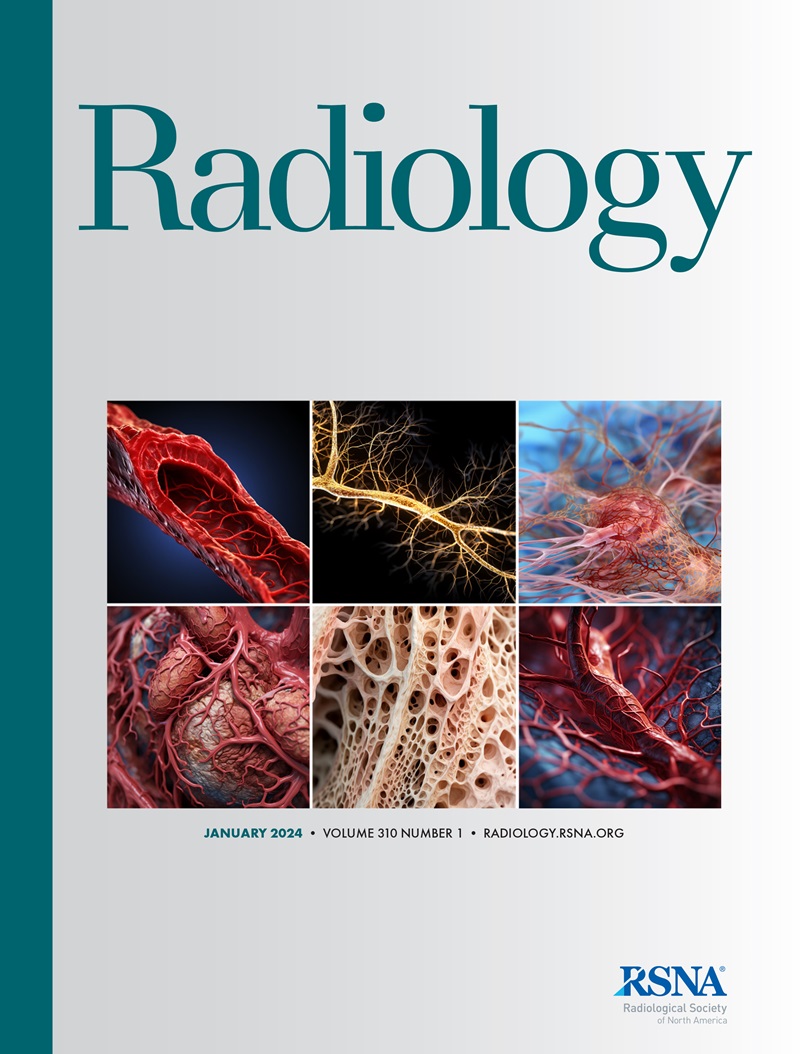Use of Pretreatment Perfusion MRI-based Intratumoral Heterogeneity to Predict Pathologic Response of Triple-Negative Breast Cancer to Neoadjuvant Chemoimmunotherapy.
Toulsie Ramtohul, Victoire Lepagney, Claire Bonneau, Maxime Jin, Emmanuelle Menet, Juliette Sauge, Enora Laas, Emanuela Romano, Diana Bello-Roufai, Fatima Mechta-Grigoriou, Anne Vincent Salomon, François-Clément Bidard, Adriana Langer, Caroline Malhaire, Luc Cabel, Hervé J Brisse, Anne Tardivon
求助PDF
{"title":"Use of Pretreatment Perfusion MRI-based Intratumoral Heterogeneity to Predict Pathologic Response of Triple-Negative Breast Cancer to Neoadjuvant Chemoimmunotherapy.","authors":"Toulsie Ramtohul, Victoire Lepagney, Claire Bonneau, Maxime Jin, Emmanuelle Menet, Juliette Sauge, Enora Laas, Emanuela Romano, Diana Bello-Roufai, Fatima Mechta-Grigoriou, Anne Vincent Salomon, François-Clément Bidard, Adriana Langer, Caroline Malhaire, Luc Cabel, Hervé J Brisse, Anne Tardivon","doi":"10.1148/radiol.240575","DOIUrl":null,"url":null,"abstract":"<p><p>Background Neoadjuvant chemoimmunotherapy (NACI) has significantly increased the rate of pathologic complete response (pCR) in patients with early-stage triple-negative breast cancer (TNBC), although predictors of response to this regimen have not been identified. Purpose To investigate pretreatment perfusion MRI-based radiomics as a predictive marker for pCR in patients with TNBC undergoing NACI. Materials and Methods This prospective study enrolled women with early-stage TNBC who underwent NACI at two different centers from August 2021 to July 2023. Pretreatment dynamic contrast-enhanced MRI scans obtained using scanners from multiple vendors were analyzed using the Tofts model to segment tumors and analyze pharmacokinetic parameters. Radiomics features were extracted from the rate constant for contrast agent plasma-to-interstitial transfer (or <i>K</i><sup>trans</sup>), volume fraction of extravascular and extracellular space (<i>V</i><sub>e</sub>), and maximum contrast agent uptake rate (Slope<sub>max</sub>) maps and analyzed using unsupervised correlation and least absolute shrinkage and selector operator, or LASSO, to develop a radiomics score. Score effectiveness was assessed using the area under the receiver operating characteristic curve (AUC), and multivariable logistic regression was used to develop a multimodal nomogram for enhanced prediction. The discrimination, calibration, and clinical utility of the nomogram were evaluated in an external test set. Results The training set included 112 female participants from center 1 (mean age, 52 years ± 11 [SD]), and the external test set included 83 female participants from center 2 (mean age, 47 years ± 11). The radiomics score demonstrated an AUC of 0.80 (95% CI: 0.70, 0.89) for predicting pCR. A nomogram incorporating the radiomics score, grade, and Ki-67 yielded an AUC of 0.86 (95% CI: 0.78, 0.94) in the test set. Associations were found between higher radiomics score (>0.25) and tumor size (<i>P</i> < .001), washout enhancement (<i>P</i> = .01), androgen receptor expression (<i>P</i> = .009), and programmed death ligand 1 expression (<i>P</i> = .01), demonstrating a correlation with tumor immune environment in participants with TNBC. Conclusion A radiomics score derived from pharmacokinetic parameters at pretreatment dynamic contrast-enhanced MRI exhibited good performance for predicting pCR in participants with TNBC undergoing NACI, and could potentially be used to enhance clinical decision making. © RSNA, 2024 <i>Supplemental material is available for this article.</i> See also the editorial by Rauch in this issue.</p>","PeriodicalId":20896,"journal":{"name":"Radiology","volume":"312 3","pages":"e240575"},"PeriodicalIF":15.2000,"publicationDate":"2024-09-01","publicationTypes":"Journal Article","fieldsOfStudy":null,"isOpenAccess":false,"openAccessPdf":"","citationCount":"0","resultStr":null,"platform":"Semanticscholar","paperid":null,"PeriodicalName":"Radiology","FirstCategoryId":"3","ListUrlMain":"https://doi.org/10.1148/radiol.240575","RegionNum":1,"RegionCategory":"医学","ArticlePicture":[],"TitleCN":null,"AbstractTextCN":null,"PMCID":null,"EPubDate":"","PubModel":"","JCR":"Q1","JCRName":"RADIOLOGY, NUCLEAR MEDICINE & MEDICAL IMAGING","Score":null,"Total":0}
引用次数: 0
引用
批量引用
Abstract
Background Neoadjuvant chemoimmunotherapy (NACI) has significantly increased the rate of pathologic complete response (pCR) in patients with early-stage triple-negative breast cancer (TNBC), although predictors of response to this regimen have not been identified. Purpose To investigate pretreatment perfusion MRI-based radiomics as a predictive marker for pCR in patients with TNBC undergoing NACI. Materials and Methods This prospective study enrolled women with early-stage TNBC who underwent NACI at two different centers from August 2021 to July 2023. Pretreatment dynamic contrast-enhanced MRI scans obtained using scanners from multiple vendors were analyzed using the Tofts model to segment tumors and analyze pharmacokinetic parameters. Radiomics features were extracted from the rate constant for contrast agent plasma-to-interstitial transfer (or K trans ), volume fraction of extravascular and extracellular space (V e ), and maximum contrast agent uptake rate (Slopemax ) maps and analyzed using unsupervised correlation and least absolute shrinkage and selector operator, or LASSO, to develop a radiomics score. Score effectiveness was assessed using the area under the receiver operating characteristic curve (AUC), and multivariable logistic regression was used to develop a multimodal nomogram for enhanced prediction. The discrimination, calibration, and clinical utility of the nomogram were evaluated in an external test set. Results The training set included 112 female participants from center 1 (mean age, 52 years ± 11 [SD]), and the external test set included 83 female participants from center 2 (mean age, 47 years ± 11). The radiomics score demonstrated an AUC of 0.80 (95% CI: 0.70, 0.89) for predicting pCR. A nomogram incorporating the radiomics score, grade, and Ki-67 yielded an AUC of 0.86 (95% CI: 0.78, 0.94) in the test set. Associations were found between higher radiomics score (>0.25) and tumor size (P < .001), washout enhancement (P = .01), androgen receptor expression (P = .009), and programmed death ligand 1 expression (P = .01), demonstrating a correlation with tumor immune environment in participants with TNBC. Conclusion A radiomics score derived from pharmacokinetic parameters at pretreatment dynamic contrast-enhanced MRI exhibited good performance for predicting pCR in participants with TNBC undergoing NACI, and could potentially be used to enhance clinical decision making. © RSNA, 2024 Supplemental material is available for this article. See also the editorial by Rauch in this issue.
利用基于治疗前灌注磁共振成像的瘤内异质性预测三阴性乳腺癌对新辅助化疗免疫疗法的病理反应
背景 新辅助化疗免疫疗法(NACI)显著提高了早期三阴性乳腺癌(TNBC)患者的病理完全应答率(pCR),但该疗法的应答预测指标尚未确定。目的 研究基于核磁共振成像的预处理灌注放射组学作为接受 NACI 治疗的 TNBC 患者 pCR 的预测指标。材料与方法 这项前瞻性研究招募了2021年8月至2023年7月在两个不同中心接受NACI治疗的早期TNBC女性患者。采用 Tofts 模型对多个供应商的扫描仪获得的治疗前动态对比增强 MRI 扫描进行分析,以分割肿瘤并分析药代动力学参数。从造影剂血浆向间质转移的速率常数(或 Ktrans)、血管外和细胞外空间的体积分数(Ve)以及最大造影剂摄取率(Slopemax)图中提取放射组学特征,并使用无监督相关性和最小绝对收缩和选择算子(或 LASSO)进行分析,以得出放射组学评分。使用接收者操作特征曲线下面积(AUC)评估评分效果,并使用多变量逻辑回归法绘制多模态提名图,以增强预测效果。通过外部测试集评估了提名图的区分度、校准和临床实用性。结果 训练集包括来自中心 1 的 112 名女性参试者(平均年龄为 52 岁 ± 11 [SD]),外部测试集包括来自中心 2 的 83 名女性参试者(平均年龄为 47 岁 ± 11)。放射组学评分预测 pCR 的 AUC 为 0.80(95% CI:0.70,0.89)。结合放射组学评分、分级和 Ki-67 的提名图在测试集中的 AUC 为 0.86(95% CI:0.78, 0.94)。在较高的放射组学评分(>0.25)与肿瘤大小(P < .001)、冲洗增强(P = .01)、雄激素受体表达(P = .009)和程序性死亡配体 1 表达(P = .01)之间发现了相关性,这表明 TNBC 患者的肿瘤免疫环境与之相关。结论 从治疗前动态对比度增强 MRI 的药代动力学参数得出的放射组学评分在预测接受 NACI 的 TNBC 患者的 pCR 方面表现良好,有可能用于加强临床决策。© RSNA, 2024 这篇文章有补充材料。另请参阅本期 Rauch 的社论。
本文章由计算机程序翻译,如有差异,请以英文原文为准。


